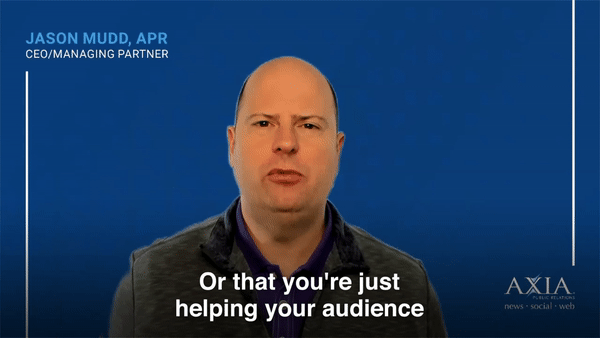The Public Relations Blog
We frequently blog about the latest public relations corporation communications, and marketing topics, tips, and trends. Our blog is one of the 100 Best Public Relations Blogs, according to FeedSpot. Please help yourself to our insights and be sure to subscribe to our weekly blog notifications.
Make sure your audience sees the best of your company on all platforms.
Content is vital in the world of online public relations, especially since it’s the cornerstone of all online PR efforts. Great content can elevate your company in a way that makes it just as powerful as classic public relations content, such as interviews or being a guest speaker at a major industry conference.
However, you need a place to put content somewhere, and that “somewhere” is platforms. Platforms can be social media websites like Facebook and Instagram or your own site. But trends can change, and platforms that looked like they had potential a few years ago can be dead in the water. This can cause problems, as users will be seeing old and out-of-date content that might not no longer reflect your company’s current views and stances, which can easily damper your online PR.
Read More
Topics: online public relations, shared media, owned media, social media, web media
Learn how newsrooms post stories and content on their websites and what to expect when your story goes live with our host, Jason Mudd. Jason is the managing partner of Axia Public Relations.
Guest:
Jason Mudd, On Top of PR host, helps companies get on Undercover Boss. He is a trusted adviser and dynamic strategist for some of America’s most admired brands. Since 1994, he’s worked with American Airlines, Budweiser, Dave & Buster’s, H&R Block, Hilton, HP, Miller Lite, New York Life, Pizza Hut, Southern Comfort, and Verizon. He founded Axia Public Relations in July 2002.
Topic:
The one with Jason Mudd on understanding a news outlet’s website.
Read More
Topics: owned media, news media, On Top of PR, solocast
A guide to the five types of media your company needs
Before diving head-first into the different types of media, it’s important to first dip your toes in the water and learn what media is. Media is a communication tool used to deliver information. The three types of media are commonly known as news media, social media, and web media, but you might also see them referred to as earned media, shared media, and owned media.
Some other forms of modern media are print media, television, movies, and video games.
Read More
Topics: shared media, earned media, owned media, social media, news media, web media
How earned media has changed, and what we have learned from it
Earned media is any material that has been written about you or your business that you haven’t paid for. It can be written off as “free publicity” for your company. Over the years, it has changed and is now presented through different media channels. Before, it used to be a 90-minute segment on a news channel, but now it can be seen as a 60-word tweet.
Nonetheless, earned media can get confusing when it involves publicity. When you pay a news source to write a piece on your business, that is known as paid media. When you write an article for your website, that is known as owned media.
Today, customers are heavily influenced by things they see on social media. Earned media plays a huge role in what is shared online, and we can learn a lot from it.
Read More
Topics: shared media, earned media, owned media
Less page requests can mean more traffic
How many times have you visited a website and found it slow to load? Is your own company’s website also one that tends to drag as it loads? A website that is slow to load negatively impacts the user – your client’s – experience. It can impact the overall experience so much that prospective clients may leave your site and go find or fill their needs elsewhere.
You ask yourself (and your IT team) why this is happening. Most likely it’s not because your internet speed isn’t good but rather because there are too many page requests or hypertext transfer protocol requests.
Read More
Topics: web design & development, owned media, web media
Know how to best share your company’s message
Earned media coverage is built awareness about your company through efforts like media relations (connecting with reporters), blogger relations, influencers, and word-of-mouth. It’s counterpart is paid media, which is advertisements that you or your company creates or pays for about itself. We have many clients ask us the difference between earned and paid media, and in the same breath, they also ask us to create a press release to earn media coverage.
Read More
Topics: earned media, owned media, news media
Don’t make this distribution mistake when pitching to the news media
PR and marketing departments get busy. They know they need to share their company’s news with the media but far too often, they simply get caught up in day-to-day tasks. When your PR and marketing departments get busy, then they can get lazy about distributing news to the media. Here’s a mistake your team may be making, why it’s a mistake, and the right way to handle it.
Read More
Topics: media relations, earned media, owned media
Do you know about the freshness factor?
It is an element of search engine algorithms that prefers web pages with fresh and updated content over outdated ones.
This is where website management triggers your online visibility. It informs search engines that you have new and relevant content for its users. When the bots index your web pages, Google rewards you with top rankings on the SERPs.
There’s more to why you need an updated website with SEO-friendly content. Let’s discover what!
Read More
Topics: SEO, online public relations, owned media
Here are seven types of premium content to guide a lead through the buying process
When it comes to capturing leads, it all boils down to providing value. Why would your visitors give you their priced personal information? They will only if you offer them something equally valuable that can be swapped with their confidential data.
But what information is more treasured than regular content?
Read More
Topics: PR tips, online public relations, owned media
The term CTA is often used when discussing media pitches, website engagement, and social media marketing. For such an important term in the public relations and marketing industry, many people don’t know what CTA stands for or its importance, so let’s break it down.
CTA stands for call to action. It originates from the marketing industry, referring to a piece of content in the form of an image, specific text, or website button.
The use of this particular content was intended to elicit a specific action from the viewer. It was typically created as a way to provide direction or instruction, such as “sign up here,” “buy now,” “follow,” etc.
Read More
Topics: PR tips, owned media, web media












Comment on This Article